May 12, 2013
On the night of May 12 we had a late spring hard freeze (28 degrees F) after many of the buds had started growing, and right before the freeze we covered each of the 40 vines with an aluminized polyethylene tarp, clipped at the bottom and sides with clothespins:
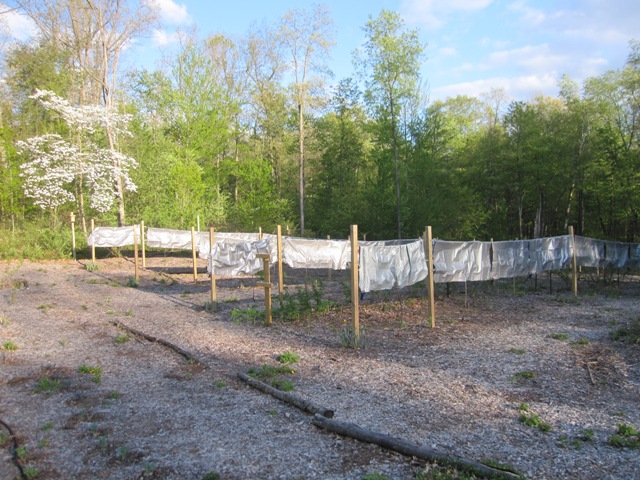
The vines still froze pretty hard, enough to kill nearly all of the shoots that had started growing, but they quickly sprouted new shoots from the secondary buds and seem to have done okay. We think the tarps helped, and if a similar situation arises again we’ll use tarps plus drip hoses to keep a flow of water over the vines during a hard freeze.
July 21, 2013
Here’s how the vineyard looks today:
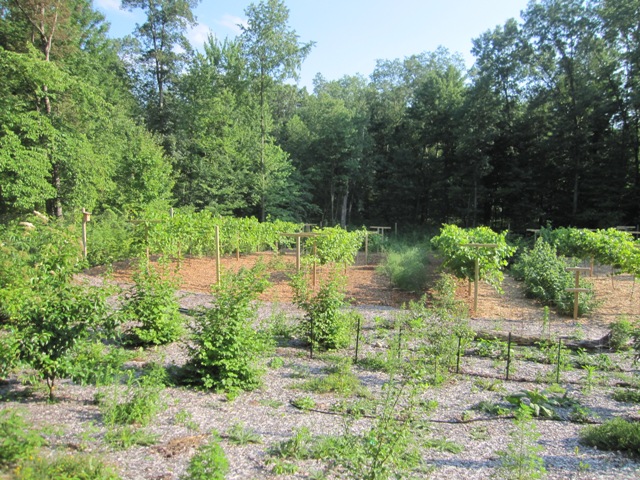
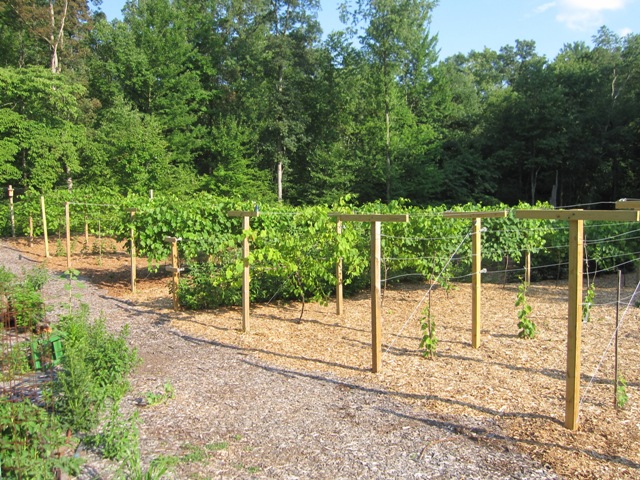
As you can see in the photos above, the mature vines (now in their third year) occupy four rows on the left, each of which holds 10 vines. The newly planted vines are on the right (more about those below). We originally planted 8 vines each of four varieties of wine grapes, plus 2 vines each of four varieties of seedless table grapes. Because this is only their third year, we thinned the flower clusters to one or two per shoot in order reduce the amount of fruit they will set. We’re aiming for 5 – 10 pounds of fruit per vine depending on how vigorous they seem; in subsequent years they should be able to handle about twice that much fruit but we want to avoid over-cropping the vines while they’re still getting established.
Frontenac
The Frontenac have done really well this year, and seemed to recover quite well from the late freeze. They lost all the shoots that had started to grow, but the secondary buds soon sprouted and bore vigorous shoots with lots of flower clusters that we thinned quite a bit. They have set large fruit clusters, well-filled but still fairly loose, and they seem fairly resistant to fungal diseases. We’ve had to pull a few bad grapes from each vine after early summer rains brought on some black rot fungus but overall it’s been only a minor problem.
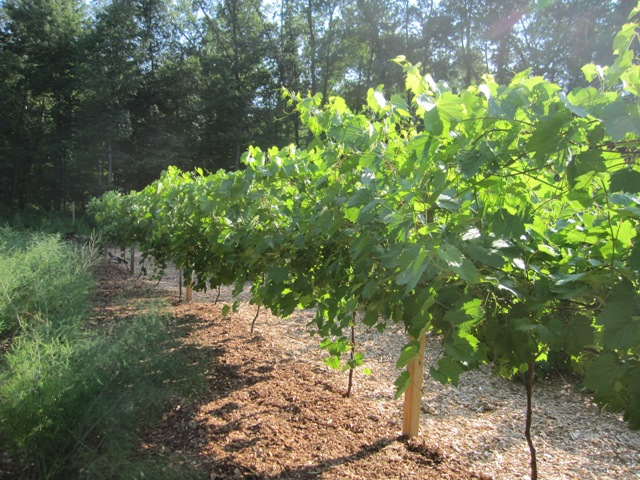
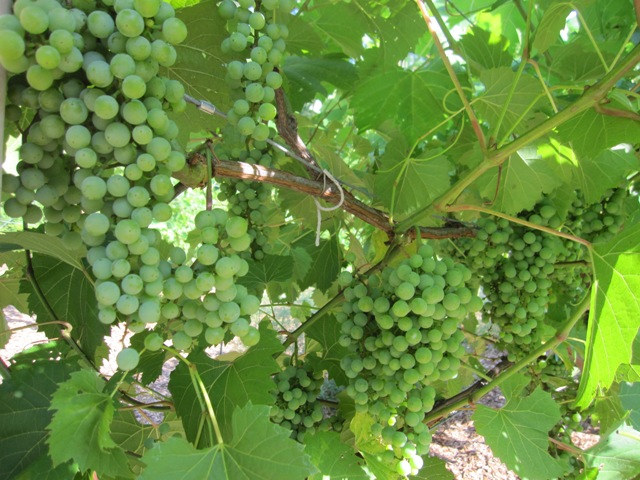
Frontenac Gris
The gray-skinned variant of Frontenac (a white wine grape) is growing very similarly, showing good recovery from the late freeze and has set some nice-looking fruit.
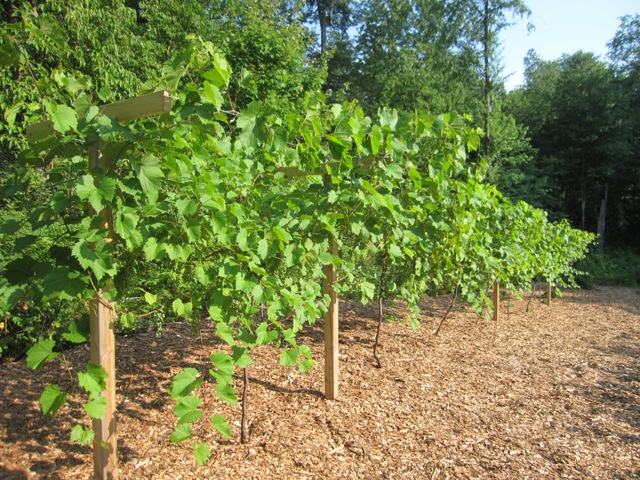

Marquette
The Marquette was hit the hardest by the late freeze and has been slow to recover. Because the vines were showing weak growth we thinned the flower clusters even more than the other varieties in order to help the vines recover. They seem to be coming back nicely and although the crop is small, the fruit seems to have good quality and little or no fungus problems so far. The fruit clusters are smaller than Frontenac and we tried to keep them to under 5 pounds per vine, considerably less on some vines that seemed slow to recover.
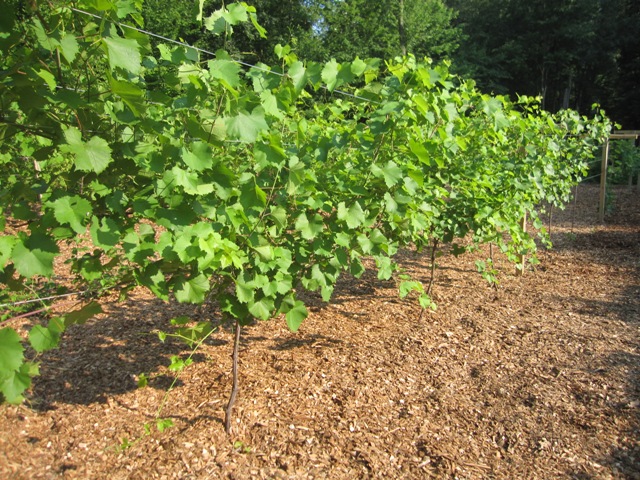
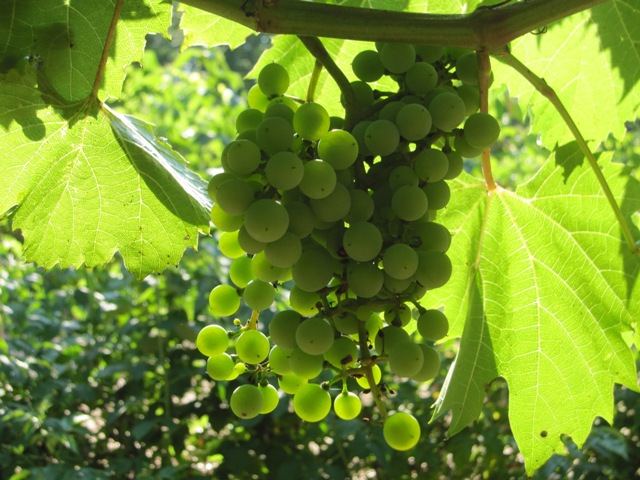
Leon Millot
Although the Leon Millot seemed to recover okay from the freeze, the vines are showing signs of stress. As you can see in the first photo below, some of the vines (note the one on the left) have yellowish leaves and we’ve continued to thin the fruit on those vines to help them recover. As the second photo shows, some of the vines are growing well and setting some nice-looking fruit clusters. The clusters are very dense, much more so than the Frontenac and Marquette, which has made it difficult to pick out any bad berries when we find them.
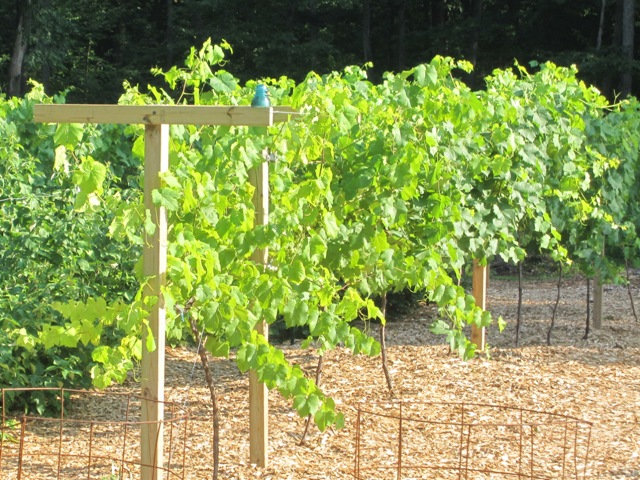

The first photo below shows a Leon Millot cluster with one grape at the top of the lower cluster showing the telltale brown spot of a fungus infection, most likely black rot. Early on it doesn’t look so bad, but eventually the whole berry shrivels and becomes black before releasing spores to spread the infection. We pull the berries as soon as we see any sign of brown spots and so far it’s been only a minor problem. The Leon Millot have shown about the same level of this as the other varieties. The second photo shows how dense some of the Leon Millot clusters are. Next year we may try combing the flower clusters to thin them out so the berries won’t be packed so tightly. At the lower left of the second photo you can see some aerial roots sprouting from the bottom of the cane. This is a common sign of freeze injury, showing that the canes were somewhat injured by the late freeze even though they continue to send out healthy shoots. The aerial roots don’t really cause a problem and we’ll just leave them alone, but they do give us an indication that the vines are stressed so we’ve been reducing the crop load on these vines by cutting out any clusters that don’t look healthy or that have more than a few bad berries. We’re still expecting a modest crop from the Leon Millot this year, perhaps 4 to 5 pounds per vine.


Reliance
Of the four seedless varieties we planted (along with Himrod, Mars and Canadice), the Reliance grapes have done the best. Early on the grapes showed some downy mildew and we culled some entire clusters as well as quite a few individual berries, but the remaining clusters are looking pretty good. The vines got off to a slow start this year, perhaps because of the late freeze, so they didn’t set a lot of fruit but we may get a few pounds from them. More importantly, the vines are looking better now so next year we expect they will do well.


Trellis and Training System
Originally we put in a three-wire trellis with wires at 4, 5 and 6 feet above ground level. This is a little higher than is typical in our region, but getting the grapes higher off the ground makes them easier to work on and tends to get them warmer, which helps them to ripen. Some of our vines are quite vigorous, and they easily produce shoots 10 feet long or more, so keeping them off the ground on the 3-wire trellis was a challenge. This spring we installed two more wires on cross-braces, about 4 feet apart and 7 feet off the ground. This gives us places to tie up the long shoots and keeps the fruit zone more exposed so it’s easier to work on. We are continually tying up shoots with twine, which is a bit of work but it’s enjoyable and it’s better than having to step over shoots on the ground. By spreading the upper canopy over a wider area, we enable the vines to collect more sunshine which should yield healthier vines and better grapes. Plus the increased air circulation around the grapes should help them dry faster in the morning or after rains, to reduce problems with fungal diseases. So far it seems to be working, as we’ve had only minor problems with fungus and we haven’t sprayed with any kind of fungicide. The only spray we have used is Bacillus thuringiensis, a natural biological control for caterpillars that we hope will reduce the incidence of grape berry moth caterpillars. So far we haven’t found any this year but it’s still early.

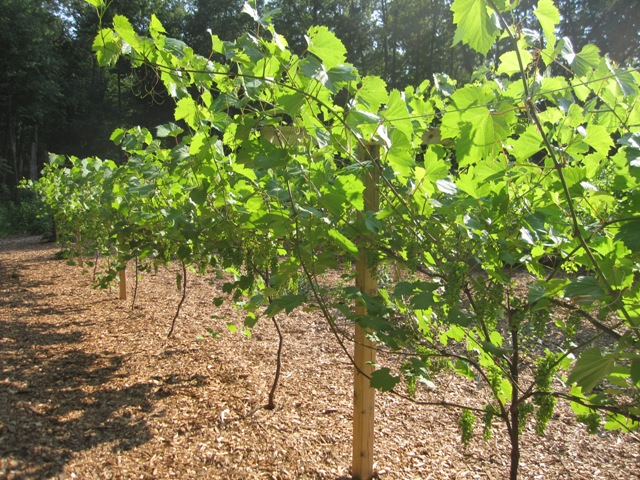
Below is a view showing the vine structure and how we train them. We are using our own variation of a Kniffen pruning system, which is an old system of grape training that is very common in this part of the country. The only permanent part of the vine will be the central vertical trunk and short renewal spurs (stubs) coming off the trunk just below the wires. Each spring, the vine is cut back to four to six canes that grew the previous year, tied loosely to the wires and cut to have about 10 buds each (the number of buds isn’t crucial and we usually just cut them halfway over to the next vine). Everything else is removed, about 90 percent of the vine! The fruit is borne on the vigorous green shoots that grow from these 4 or 6 arms, and these shoots typically get anywhere from 4 to 8 feet long on our vines, and sometimes even longer. Next year, the cycle repeats and we cut off the old fruiting canes and most of the rest, retaining only the strongest 4 to 6 new canes that originated near the main trunk.
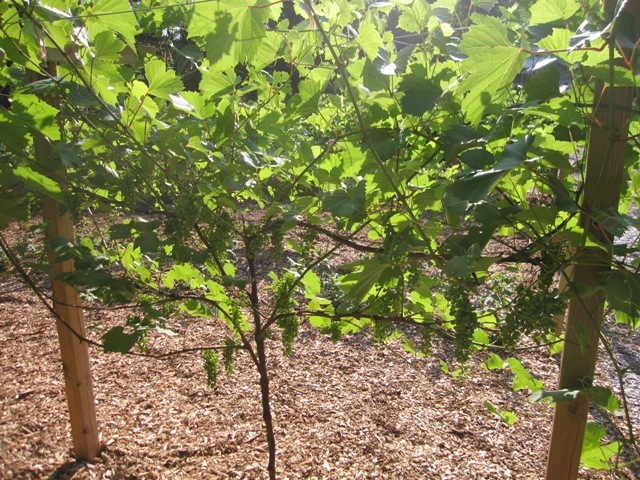
Our variation on the Kniffen system is to add 2 extra wires on cross braces similar to a Geneva Double Curtain trellis, so that we have more places to tie up the shoots as they grow. We don’t try to control them too much, as with the Vertical Shoot Positioning system; we just keep them off the ground and out of our way as we work on the fruit, and try to give them as much space as possible to grow overhead. It’s pretty much a riot of shoots going every which way up there but that’s just fine, as they will all get cut off in the spring anyway. At it’s heart it is still a Kniffen system because we’re removing the horizontal canes every year, which has the advantage of being more resistant to winter injury because they canes are renewed every year. We just spread out the canopy much more than a Kniffen system typically would, by using the extra wires on the cross braces.
New Grapes
This spring we expanded the vineyard with space for 40 more vines by adding three 12-vine rows plus extending the original 4 rows by one vine each into spaces we had originally planned for kiwi vines. So now we have space for a total of 80 grape vines, though we have a few open spaces here and there that we’ll fill in with another seedless variety next spring.
The new cultivars we planted this spring are Traminette, which is a spicy white-wine grape, St. Croix, a red wine variety that has relatively low acid and should blend well with our high-acid Frontenac, and Petite Pearl, an extremely cold-tolerant red wine variety that was recently introduced. The young vines are all doing well and we’ve started training them up stakes:
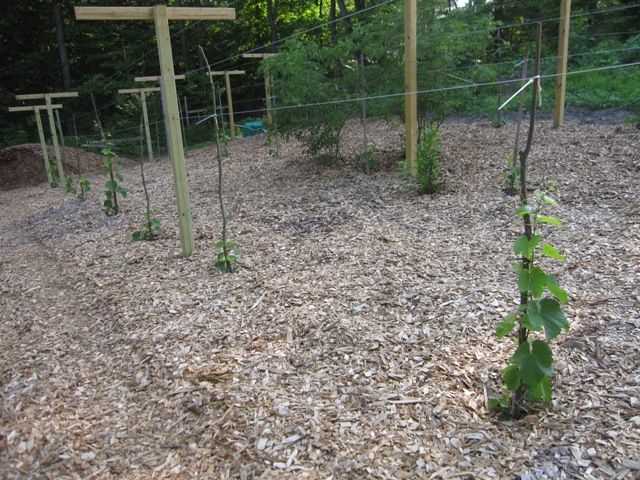
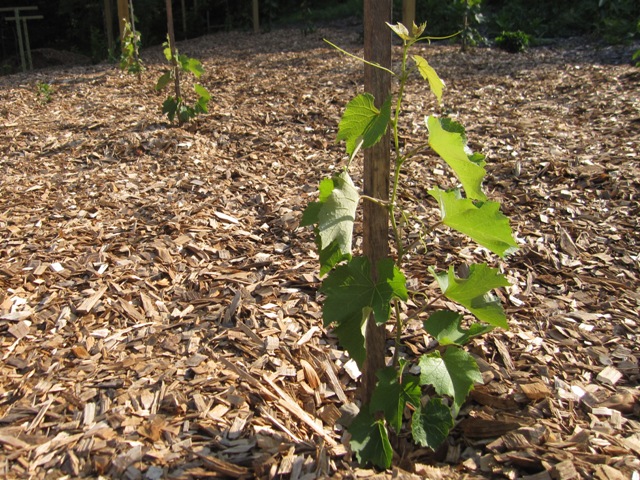
It’s not strictly necessary to train them up like this in the first year, but we prefer to because it keeps the young shoots off the ground. If they put out good growth that survives the winter well, this will become the trunk of the mature vine. If not, then we’ll cut them to the ground in the spring and train up a vigorous new shoot to become the trunk.